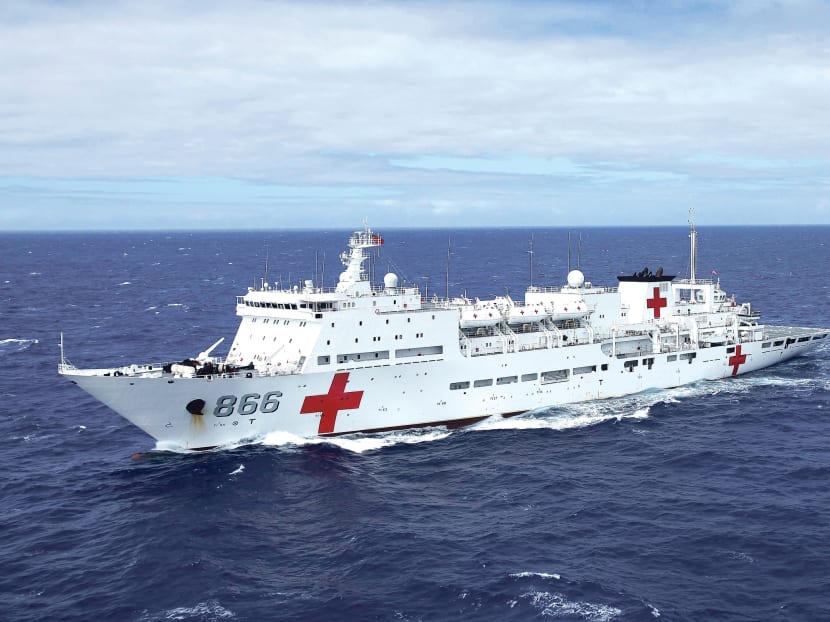New China drills in disputed waters set to rile tensions
BEIJING — China is holding military drills across the East and South China Seas that may further disrupt domestic air travel and add to tensions with neighbours over territorial disputes in the region.

A Chinese People’s Liberation Army Navy ship, Peace Ark, sails off the south-east of Oahu, Hawaii, during the Rim of the Pacific Exercise on Wednesday. China is participating in the exercise this year in a rare sign of cooperation with the US and Japan. Photo: Reuters
BEIJING — China is holding military drills across the East and South China Seas that may further disrupt domestic air travel and add to tensions with neighbours over territorial disputes in the region.
Beijing begins five days of drills in the East China Sea tomorrow, the Ministry of National Defence said in a statement on its website. Those exercises, which the ministry called routine, come while China is holding live-fire drills off Beibu Bay, or the Gulf of Tonkin, near Vietnam and drills in the Bohai Strait that both end on Friday.
While the scale of the current drills is bigger than in the past, it is a coincidence the annual exercises are being held at the same time, Beijing News reported today, citing Mr Zhang Junshe, a researcher at the Navy Military Research Institute.
President Xi Jinping has been expanding the reach of the country’s navy and using the added muscle to more aggressively assert territorial claims in the region.
Chinese and Japanese ships regularly tail one another off disputed islands in the East China Sea, while deadly anti-Chinese riots broke out in Vietnam in May after China set up an oil rig in waters also claimed by that country. The Philippines has sought United Nations arbitration in its maritime spat with China.
Beijing claims much of the South China Sea, which may be rich in energy and mineral deposits, under its nine-dash line map first published in 1947. The line extends hundreds of miles south from China’s Hainan Island to equatorial waters off the coast of Borneo, taking in some of the world’s busiest shipping lanes.
In the East China Sea, Japan and China both lay claim to a chain of uninhabited islands known as Senkaku in Japanese and Diaoyu by the Chinese. The United States has said it will come to Japan’s defence in any clash over the islands.
With the current drills, “what’s different from the past is that China is doing it in a more high-profile way, which does make China appear to be raising military tensions”, said Mr Suh Jin Young, a professor emeritus of Chinese politics at Seoul’s Korea University. “But in Chinese eyes, the tensions were begun by the US and Japan, and China thinks it’s only conducting what it has been doing annually.”
In a rare sign of military cooperation with the two countries, however, China is participating alongside the US and Japan in the five-week-long Rim of the Pacific Exercise that runs through Friday in waters off Hawaii. Beijing’s four ships make up the second-biggest naval contingent after the US of the 22 nations taking part.
The current Chinese military activity is also having repercussions on the mainland. China Southern Airlines said yesterday that its flights in the eastern part of the country might experience large-scale delays because of special activities. Airlines last week were ordered to cut a quarter of their flights at a dozen airports, including two in Shanghai, because of “high frequency exercises”, the state media reported on Tuesday.
Military and civil aviation authorities have taken steps to minimise the impact of the new drills, the ministry said in the statement.
That order was issued a week after the People’s Liberation Army began three months of live-fire drills in six regional military commands, including the one that oversees Shanghai, state-run Xinhua News Agency reported. Some training sessions would be conducted under a complex electromagnetic environment, the report said.
The military controls about 52 per cent of the airspace in eastern China, home to the country’s biggest cities of Beijing and Shanghai, said a June 2011 report by the official China News Service.
Beijing’s civil aviation uses about a fifth of available routes within the nation’s airspace, Mr Shi Boli, who heads the department of Air Transportation Regulation at CAAC, said in an interview last year. BLOOMBERG





